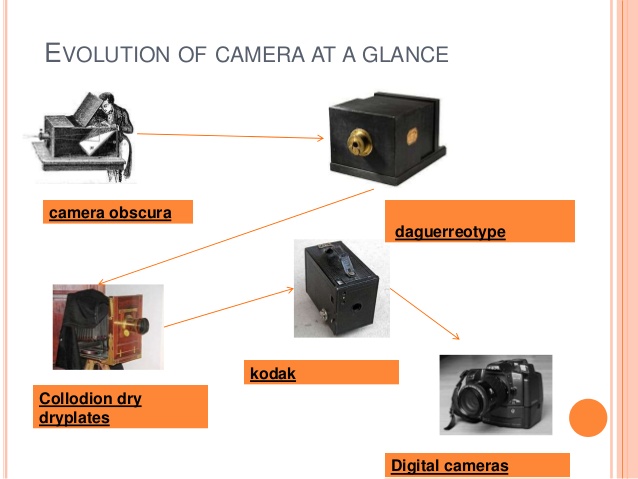A PRESENTATION ON THE EVOLUTION OF STILL CAMERA
EVOLUTION OF CAMERA AT A GLANCE camera obscura daguerreotype Collodion dry dryplates kodak Digital cameras
The history of the camera can be traced much further back than the introduction of photography. Cameras evolved from the camera obscura, and continued to change through many generations of photographic technology, including daguerreotypes, calotypes, dry plates, film, and digital cameras.
CAMERA OBSCURA – Photographic cameras were a development of the camera obscura, a device possibly dating back to the ancient Chinese and ancient Greeks which uses a pinhole or lens to project an image of the scene outside upside-down onto a viewing surface. On 24 January 1544 mathematician and instrument maker Reiners Gemma Frisius of Leuven University used one to watch a solar eclipse, publishing a diagram of his method in De Radio Astronimica et Geometrico in the following year. In 1558 Giovanni Batista della Porta was the first to recommend the method as an aid to drawing.
DAGUERREOTYPES AND CALOTYPES After Niépce’s death in 1833, his partner Louis Daguerre continued to experiment and by 1837 had created the first practical photographic process, which he named the daguerreotype and publicly unveiled in 1839. Daguerre treated a silver-plated sheet of copper with iodine vapor to give it a coating of light-sensitive silver iodide. After exposure in the camera, the image was developed by mercury vapor and fixed with a strong solution of ordinary salt (sodium chloride).
DRY PLATES Collodion dry plates had been available since 1855, thanks to the work of Désiré van Monckhoven, but it was not until the invention of the gelatin dry plate in 1871 by Richard Leach Maddox that the wet plate process could be rivaled in quality and speed. The 1878 discovery that heat-ripening a gelatin emulsion greatly increased its sensitivity finally made so-called “instantaneous” snapshot exposures practical. For the first time, a tripod or other support was no longer an absolute necessity. With daylight and a fast plate or film, a small camera could be hand- held while taking the picture.
KODAK AND THE BIRTH OF FILM The use of photographic film was pioneered by George Eastman, who started manufacturing paper film in 1885 before switching to celluloid in 1889. His first camera, which he called the “Kodak,” was first offered for sale in 1888. It was a very simple box camera with a fixed-focus lens and single shutter speed, which along with its relatively low price appealed to the average consumer. In 1900, Eastman took mass-market photography one step further with the Brownie, a simple and very inexpensive box camera that introduced the concept of the snapshot. The Brownie was extremely popular and various models remained on sale until the 1960s.
DIGITAL CAMERAS The concept of digitizing images on scanners, and the concept of digitizing video signals, predate the concept of making still pictures by digitizing signals from an array of discrete sensor elements. Handheld electronic cameras, in the sense of a device meant to be carried and used like a handheld film camera, appeared in 1981 with the demonstration of the Sony Mavica (Magnetic Video Camera). This is not to be confused with the later cameras by Sony that also bore the Mavica name.

